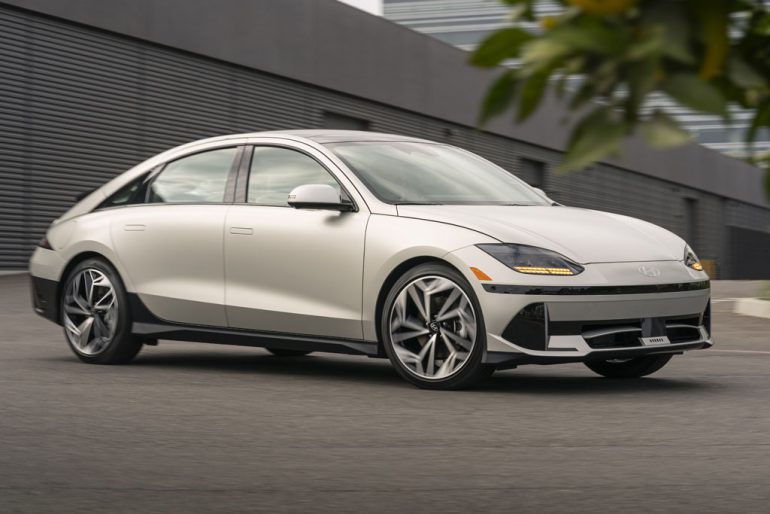
The emergence of electric vehicles (EVs) is a quest that most automakers are finally getting serious about. One of the frontrunners in such a race is Hyundai, who have introduced some rather unique EVs that are captivating many on making the move to owning a new EV. These captivating models include the all-new Hyundai Ioniq 6, which we had a chance to check out this week, walking away rather impressed and optimistic about the future of EVs.
The new Hyundai Ioniq 6 makes its debut as a midsized EV that takes on a unique design approach to not only add to its efficiency by reducing drag but adds an appeal that turns heads. The design is much like the 4-door-coupe vehicles of the past, like the Mercedes-Benz CLS or Audi A7. Such a style may cut down on headroom for rear passengers, but it does justice for an appealing look that’s different from just about everything else on the road. The large and stylish 20-inch wheels on my Ioniq 6 Limited long-range AWD test vehicle also play a part in the alluring looks of the somewhat low-slung aesthetics of the latest EV from Hyundai, which has a repeating theme of utilizing square matrix dots throughout many design elements of the vehicle from the exterior LED lighting to countless interior features. Together, the unique design makes for a bold statement but one that’s not much of a turn-off – so the Ioniq 6 is pleasing to most.
Also, don’t forget that you can get discounted new car pricing with a free quote through qualified local dealer partners.
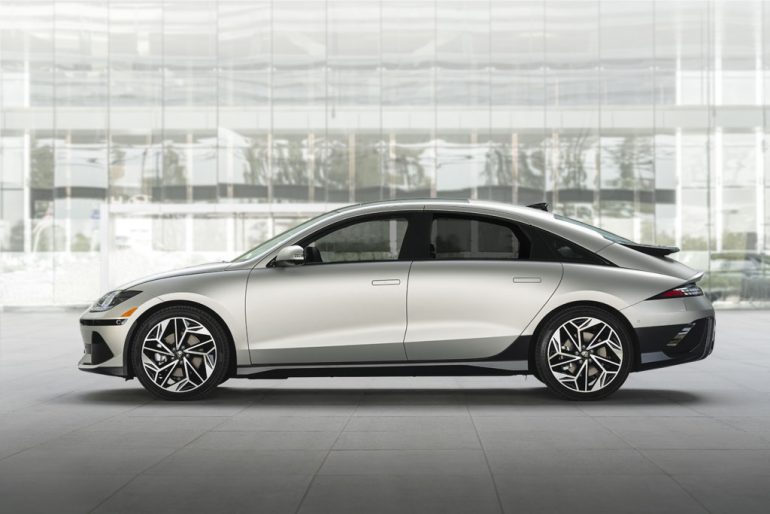
Just like the Hyundai Ioniq 5 that we reviewed last year, the new Ioniq 6 takes all that was enjoyed in a well-managed all-wheel-drive EV platform and mostly changes up the body structure into a lower, coupe-like, midsized sedan instead of the SUV-ish style of the 5. Utilizing the same drivetrain affords the opportunity to make a sleeker body that slips through the air a bit better, and that’s exactly what Hyundai has done for the Ioniq 6.
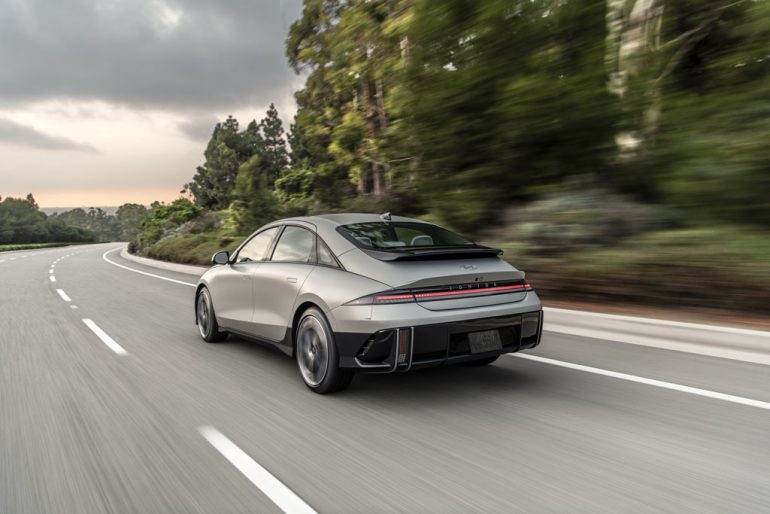
Having a total system output of 320 horsepower and 446 lb-ft of torque provided by the two motors, the Ioniq 6 feels strong and runs from zero to 60 mph in just 4.4 seconds. That acceleration, thanks to the instant torque provided by the two motors, one at each axle, comes on strong but tends to taper off a bit once you start to hit highway and Interstate speeds. Still, there’s a welcomed smoothness to the power delivery in the default Normal drive mode as opposed to the Eco mode that essentially lowers the overall power output across the throttle range but, in return, extends your driving range.
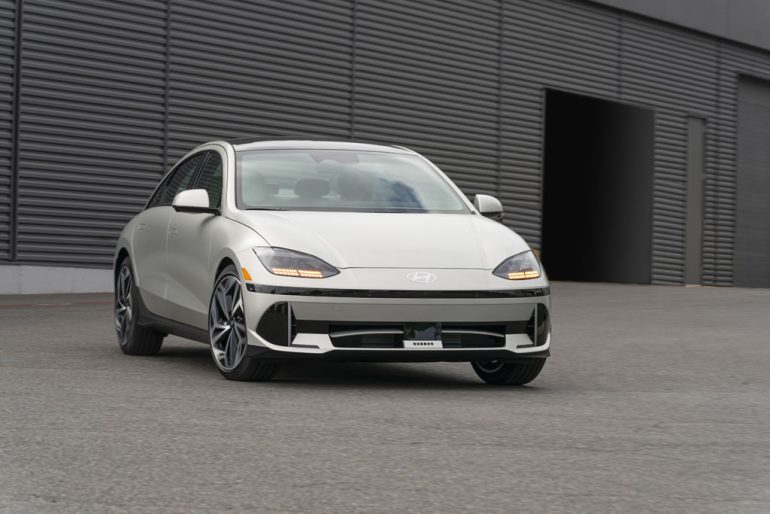
There aren’t many surprises in driving the new Ioniq 6 other than the idea of it having instant full power from the start, giving you an advantage for off-the-line performance, which is all a good thing. The suspension tuning, even with having fixed dampers, is smooth and compliant without much upset in going over road imperfections. In being an EV, the drivetrain is virtually silent, with the only bit of sound coming from the tires and, of course, the audio system and its clever Active Sound Design that adds a futuristic hum that’s in sync with your application of power and speed. Thankfully, the fake drivetrain sound is adjustable and can be disabled altogether.
Surprisingly, the Ioniq 6 handles well, but you start to feel its 4,600 pounds of curb weight once you’re into an aggressive turn. The steering feel is mostly on the heavier side and is increased when in the Sport drive mode, which is something I welcome even though the feeling is overall numb with no feedback from the road. I believe the steering is a lot heavier in the Ioniq 6 than it was in the Ioniq 5. Moreover, there’s a livelier feeling that you get with the Ioniq 6 over the Ioniq 5 where you feel more confident in zipping around town and going into turns, which is more than likely an attribute to the much lower center of gravity.
A wide array of regenerative settings can be conveniently accessed using the steering wheel paddles. These settings include several levels of regeneration, an automatic mode that uses the front radar to adjust deceleration based on approch of an oncoming vehicle, and an i-Pedal mode designed for one-pedal driving. When utilizing Level 1 regen, the experience feels quite natural. Use of the various levels starting with Level 1 and the i-Pedal modes activate the brake lights when you release the throttle, resulting in a substantial deceleration in the higher levels.
The i-Pedal setting offers a unique experience, allowing you to control the vehicle with just the throttle. Releasing the throttle in this mode smoothly brings the vehicle to a complete stop, emulating the effect of applying the brakes moderately. The transition from the motor’s regeneration to friction brakes typically feels seamless as it did in the Ioniq 5.
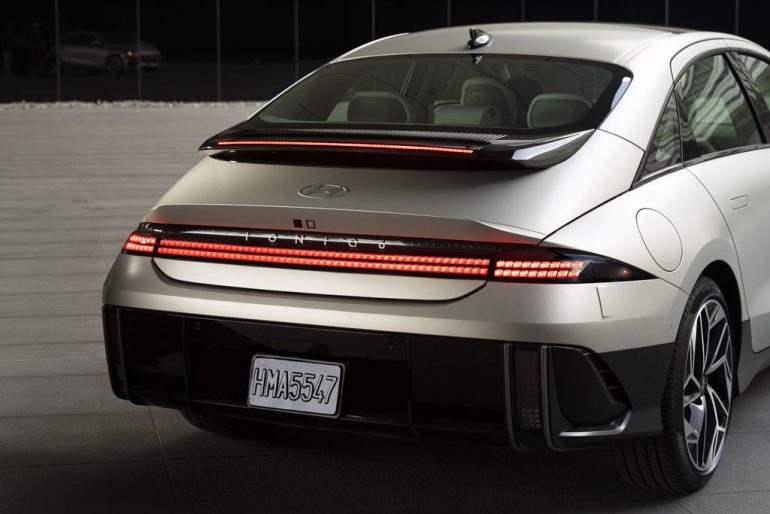
To quickly note, the Ioniq 6 can be had in a standard range rear-wheel-drive SE trim with just 149 horsepower and 258 lb-ft of torque from a single rear axle motor. From there, you can get the SE or SEL long-range RWD trims with 225 horsepower and 258 lb-ft of torque with a driving range of 361 miles in the SE or 305 miles in the SEL. With either trim, you can opt for all-wheel drive, which increases the power output to match my AWD Limited Ioniq 6 test vehicle, but you settle on a range of 270 miles.
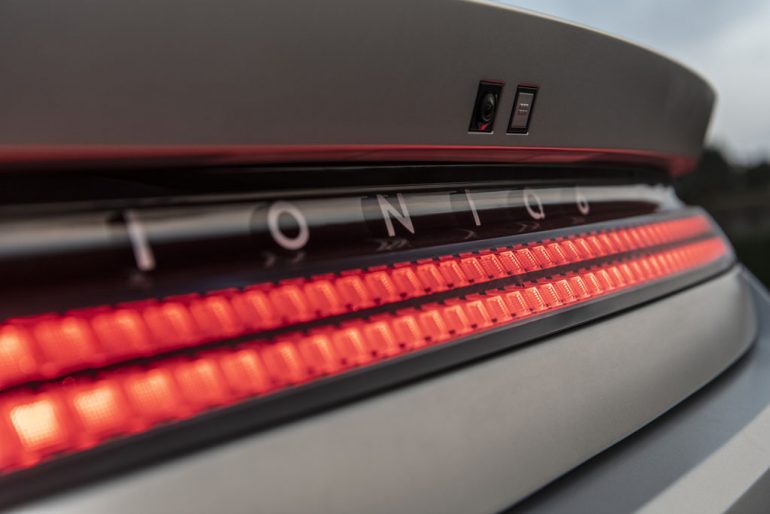
In my Ioniq 6 Limited AWD test vehicle, the electric consumption is quite good, and I am easily able to match the 270-mile estimate range when leaving the vehicle in Normal drive mode. I can see extending that range just ever so slightly when you use the Eco drive mode, where I could see getting 280 miles or more of range around town but not on the highway or Interstate. Overall, the efficiency of the Ioniq 6 is better than what I saw on the Ioniq 5, which I attribute to the sleeker body that has a 0.22 coefficient of drag compared to the Ioniq 5’s 0.288. In the city, I saw an average of about 3.4 miles per kWh, which comes to about 114 MPGe. On the highway, I averaged about 2.9 miles per kWh, which is around 97.7 MPGe. Those figures slightly best the EPA estimates of 111 MPGe city, 94 MPGe highway, and 103 MPGe combined.
Where the Ioniq 6 also shines is its ability to charge quickly, among the fastest on the current EV market, using a 350kW DC fast charger stall. Using such, you’ll manage to charge up the Ioniq 6’s 77.4 kWh, 697-volt battery pack in just 18 minutes from a 10% to 80% state of charge. Using a level 2 charger around 40 amps, you’ll charge up the battery from a 10% state of charge up to 100% in just over 7 hours.
Just like other new, well-equipped Hyundai vehicles, the Ioniq 6 is a rather user-friendly vehicle in most of its operations. Also, just like the Ioniq 5 Limited, it features an inviting 12.3-inch dual-screen setup on the dashboard where the latest touchscreen infotainment system is very responsive to inputs and proves to be among the best in the mainstream automotive business. There’s a plethora of useful feature sets and information pertinent to the EV operation of the vehicle. Moreover, the entertainment features are easy to navigate, as is the USB-connected Apple CarPlay and Android Auto integration. Still, it baffles me when Hyundai has a useful and properly placed wireless charging pad but has not offered wireless smartphone integration on the Ioniq EVs.
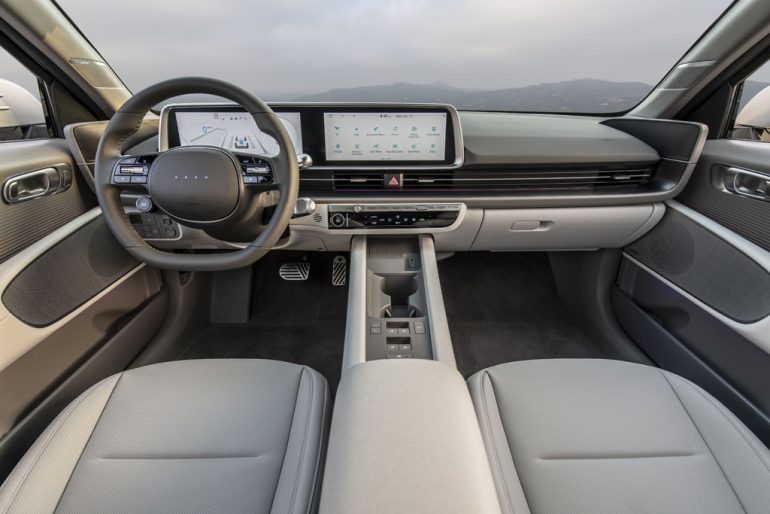
Adding to the appeal and premium feel of the Ioniq 6 is a cabin with multi-color LED ambient lighting, cleverly placed soft-touch surfaces, and a uniquely design theme using the squared matrix dots throughout.
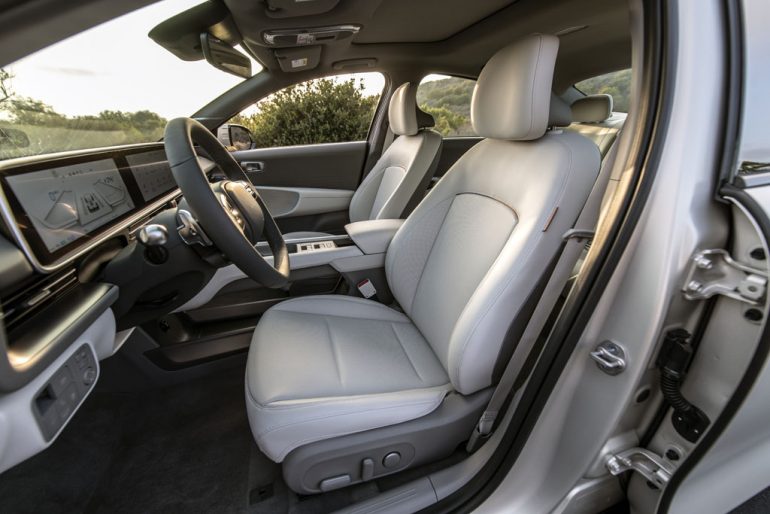
The seating areas in the Hyundai Ioniq 6 are surprisingly spacious. While the Ioniq 6 doesn’t look exactly like a midsized sedan from the outside, the interior space is very open, and the front seats offer a lot of power adjustability fitting for small to larger adults. Where things get a little concerning is the rear headroom as you’re apt to hit your head on the C pillar when entering as the slopping roof line then becomes a slight issue.
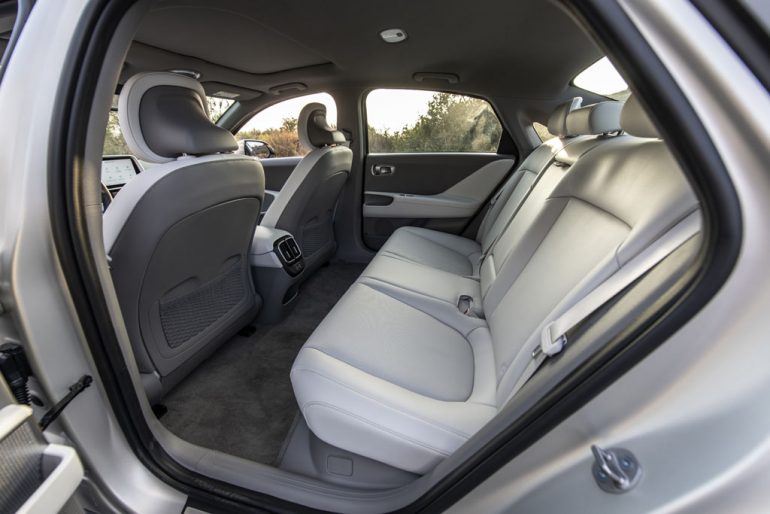
Also, the Ioniq 6 may look like it has a rear hatch that opens with the rear glass, but it does not. Instead, there’s a typical trunk opening that reveals 11.2 cubic feet of storage. Under the front hood is a small .5 cubic feet of frunk storage in an opening plastic compartment, slightly smaller than the one in the Ioniq 5.
The new Hyundai Ioniq 6 receives all of the expected active safety features, which include the highlights of forward collision warning/emergency braking, lane departure warning/lane keep assist, adaptive cruise control, 360-degree surround camera system, cross-traffic warning, and blind-spot monitors with the trick blind-spot view monitor that gives you a live camera feed in the digital gauge cluster of what is in your blind spot when you signal. Making the best use of the safety features, the 2023 Hyundai Ioniq 6 receives the Insurance Institute for Highway Safety’s Top Safety Pick+ award.
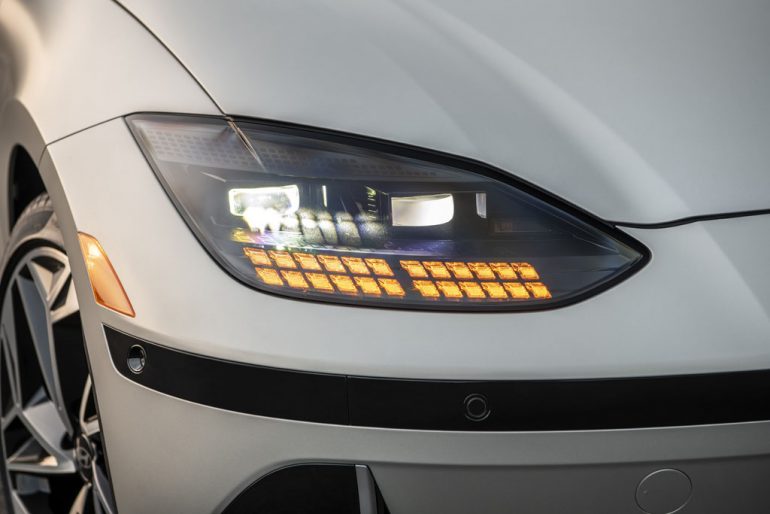
The new Hyundai Ioniq 6 starts at a price of $41,600 for the base RWD SE Standard Range model. From there, things tend to ramp up as each of the four trims has a dedicated set of features and amenities, where adding in everything for my top-trimmed Ioniq 6 Limited AWD test vehicle comes to a price of $58,425, which includes a freight and handling charge of $1,115 and the options of my test vehicle’s attractive Gravity Gold matte paint ($1,000), and carpeted floor mats ($210).